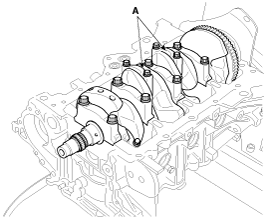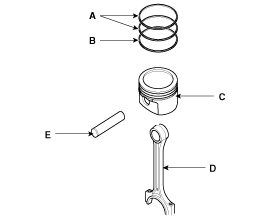Remove the ladder frame (A).

Use fender covers to avoid damaging painted surfaces.
To avoid damaging the cylinder head, wait until the engine coolant temperature drops below normal temperature (20°C [68°F]) before removing it.
When handling a metal gasket, take care not to fold the gasket or damage the contact surface of the gasket.
To avoid damage, unplug the wiring connectors carefully while holding the connector portion.
Mark all wiring and hoses to avoid misconnection.
Turn the crankshaft damper pulley so that the piston of No. 1 cylinder is at TDC (top dead center) on compression stroke.
Remove the engine and transaxle assembly from the vehicle.
(Refer to Engine and Transaxle Assembly - "Engine and Transaxle Assembly")
Remove the transaxle assembly from the engine assembly.
Manual Transaxle
(Refer to Manual Transaxle System - "Manual Transaxle")
Automatic Transaxle
(Refer to Automatic Transaxle System - "Automatic Transaxle")
Remove the drive plate or flywheel.
Automatic Transaxle
(Refer to Cylinder Block Assembly - "Drive Plate")
Manual Transaxle
(Refer to Cylinder Block Assembly - "Flywheel")
Remove the rear oil seal.
(Refer to Cylinder Block Assembly - "Rear Oil Seal")
Install the engine assembly to engine stand for disassembly.
Remove the intake manifold with the electronic throttle control (ETC) module.
(Refer to Intake And Exhaust System - "Intake Manifold")
Remove the exhaust manifold.
(Refer to Intake And Exhaust System - "Exhaust Manifold")
Remove the timing chain.
(Refer to Timing System - "Timing Chain")
Remove the cylinder head assembly.
(Refer to Cylinder Head Assembly - "Cylinder Head")
Remove the oil filter.
(Refer to Lubrication System - "Oil Filter")
Remove the oil pan and the oil screen.
(Refer to Lubrication System - "Oil Pan")
Remove the ladder frame (A).

Check the connecting rod side clearance.
Check the connecting rod bearing cap oil clearance.
Remove the piston and connecting rod assemblies.
Using a ridge reamer, remove all the carbon from the top of the cylinder.
Remove the connecting rod bearing caps (A).

Mark the connecting rod, and caps to be able to reassemble in the original position and direction.
Push the piston and connecting rod assembly with upper bearing through the top of the cylinder block.
Keep the connecting rod ands cap with their bearings assembled together.
Arrange the piston and connecting rod assemblies in the correct order.
Mark the piston and connecting rod assemblies to be able to reassemble in the original position.
Check fit between piston and piston pin.
Try to move the piston back and forth on the piston pin. If any movement is felt, replace the piston and pin as a set.
Disassemble the piston rings.
Using a piston ring expender, remove the two compression rings (A).
Remove the oil ring (two side rails and one spacer) (B) by hand.
Do not apply excessive force to remove the oil ring from piston. It may cause to break the oil ring.
Arrange the piston rings in the correct order only.
Disassemble the connecting rod (D) from the piston (C).
Using a hydraulic press, remove the piston pin (E) from piston.
